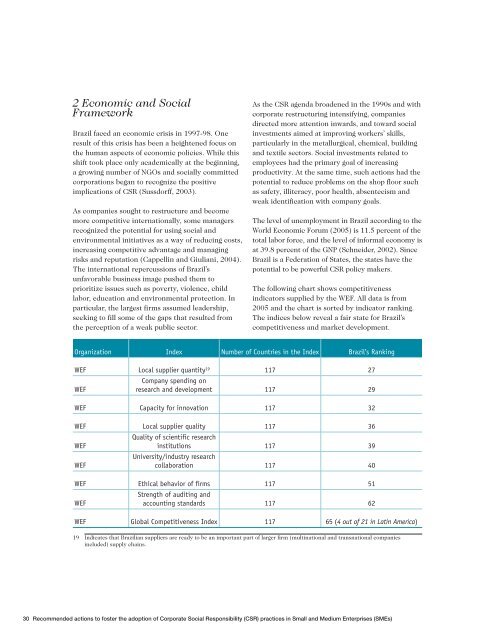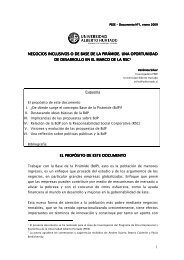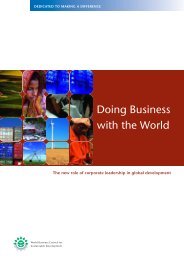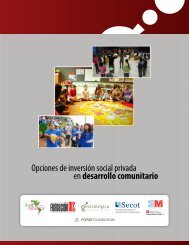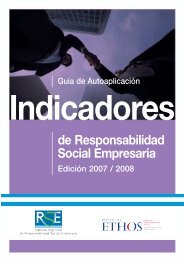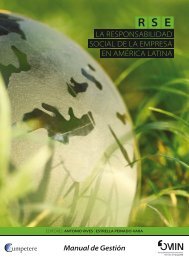Recommended actions to foster the adoption of Corporate Social ...
Recommended actions to foster the adoption of Corporate Social ...
Recommended actions to foster the adoption of Corporate Social ...
Create successful ePaper yourself
Turn your PDF publications into a flip-book with our unique Google optimized e-Paper software.
2 Economic and <strong>Social</strong>FrameworkBrazil faced an economic crisis in 1997-98. Oneresult <strong>of</strong> this crisis has been a heightened focus on<strong>the</strong> human aspects <strong>of</strong> economic policies. While thisshift <strong>to</strong>ok place only academically at <strong>the</strong> beginning,a growing number <strong>of</strong> NGOs and socially committedcorporations began <strong>to</strong> recognize <strong>the</strong> positiveimplications <strong>of</strong> CSR (Sussdorff, 2003).As companies sought <strong>to</strong> restructure and becomemore competitive internationally, some managersrecognized <strong>the</strong> potential for using social andenvironmental initiatives as a way <strong>of</strong> reducing costs,increasing competitive advantage and managingrisks and reputation (Cappellin and Giuliani, 2004).The international repercussions <strong>of</strong> Brazil’sunfavorable business image pushed <strong>the</strong>m <strong>to</strong>prioritize issues such as poverty, violence, childlabor, education and environmental protection. Inparticular, <strong>the</strong> largest firms assumed leadership,seeking <strong>to</strong> fill some <strong>of</strong> <strong>the</strong> gaps that resulted from<strong>the</strong> perception <strong>of</strong> a weak public sec<strong>to</strong>r.As <strong>the</strong> CSR agenda broadened in <strong>the</strong> 1990s and withcorporate restructuring intensifying, companiesdirected more attention inwards, and <strong>to</strong>ward socialinvestments aimed at improving workers’ skills,particularly in <strong>the</strong> metallurgical, chemical, buildingand textile sec<strong>to</strong>rs. <strong>Social</strong> investments related <strong>to</strong>employees had <strong>the</strong> primary goal <strong>of</strong> increasingproductivity. At <strong>the</strong> same time, such <strong>actions</strong> had <strong>the</strong>potential <strong>to</strong> reduce problems on <strong>the</strong> shop floor suchas safety, illiteracy, poor health, absenteeism andweak identification with company goals.The level <strong>of</strong> unemployment in Brazil according <strong>to</strong> <strong>the</strong>World Economic Forum (2005) is 11.5 percent <strong>of</strong> <strong>the</strong><strong>to</strong>tal labor force, and <strong>the</strong> level <strong>of</strong> informal economy isat 39.8 percent <strong>of</strong> <strong>the</strong> GNP (Schneider, 2002). SinceBrazil is a Federation <strong>of</strong> States, <strong>the</strong> states have <strong>the</strong>potential <strong>to</strong> be powerful CSR policy makers.The following chart shows competitivenessindica<strong>to</strong>rs supplied by <strong>the</strong> WEF. All data is from2005 and <strong>the</strong> chart is sorted by indica<strong>to</strong>r ranking.The indices below reveal a fair state for Brazil’scompetitiveness and market development.Organization Index Number <strong>of</strong> Countries in <strong>the</strong> Index Brazil’s RankingWEF Local supplier quantity 19 117 27Company spending onWEFresearch and development 117 29WEF Capacity for innovation 117 32WEF Local supplier quality 117 36WEFQuality <strong>of</strong> scientific researchinstitutions 117 39WEFUniversity/industry researchcollaboration 117 40WEF Ethical behavior <strong>of</strong> firms 117 51Strength <strong>of</strong> auditing andWEFaccounting standards 117 62WEF Global Competitiveness Index 117 65 (4 out <strong>of</strong> 21 in Latin America)19 Indicates that Brazilian suppliers are ready <strong>to</strong> be an important part <strong>of</strong> larger firm (multinational and transnational companiesincluded) supply chains.30 <strong>Recommended</strong> <strong>actions</strong> <strong>to</strong> <strong>foster</strong> <strong>the</strong> <strong>adoption</strong> <strong>of</strong> <strong>Corporate</strong> <strong>Social</strong> Responsibility (CSR) practices in Small and Medium Enterprises (SMEs)


